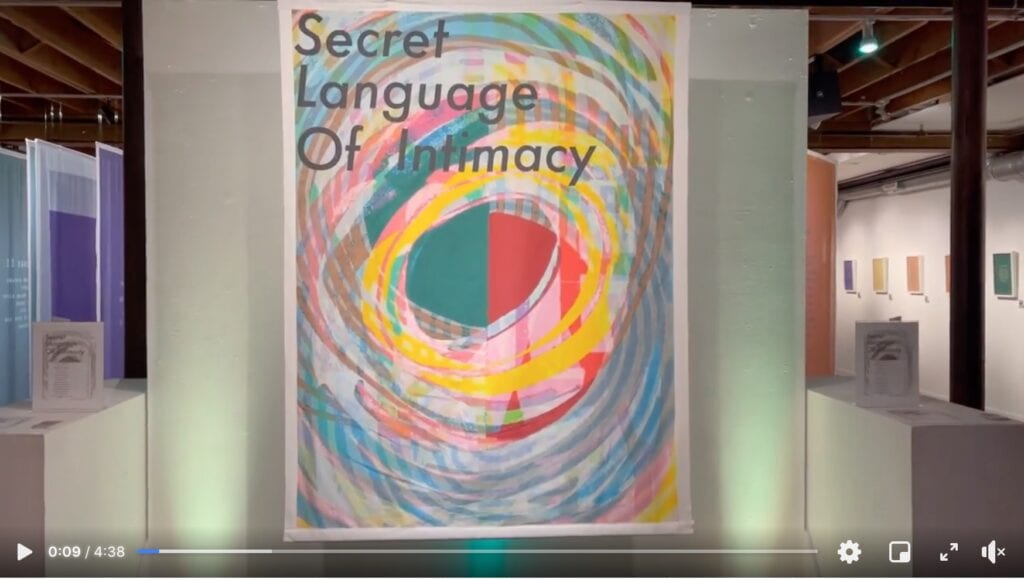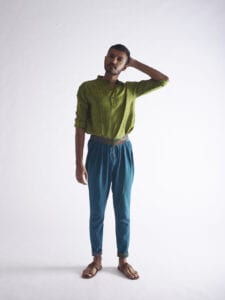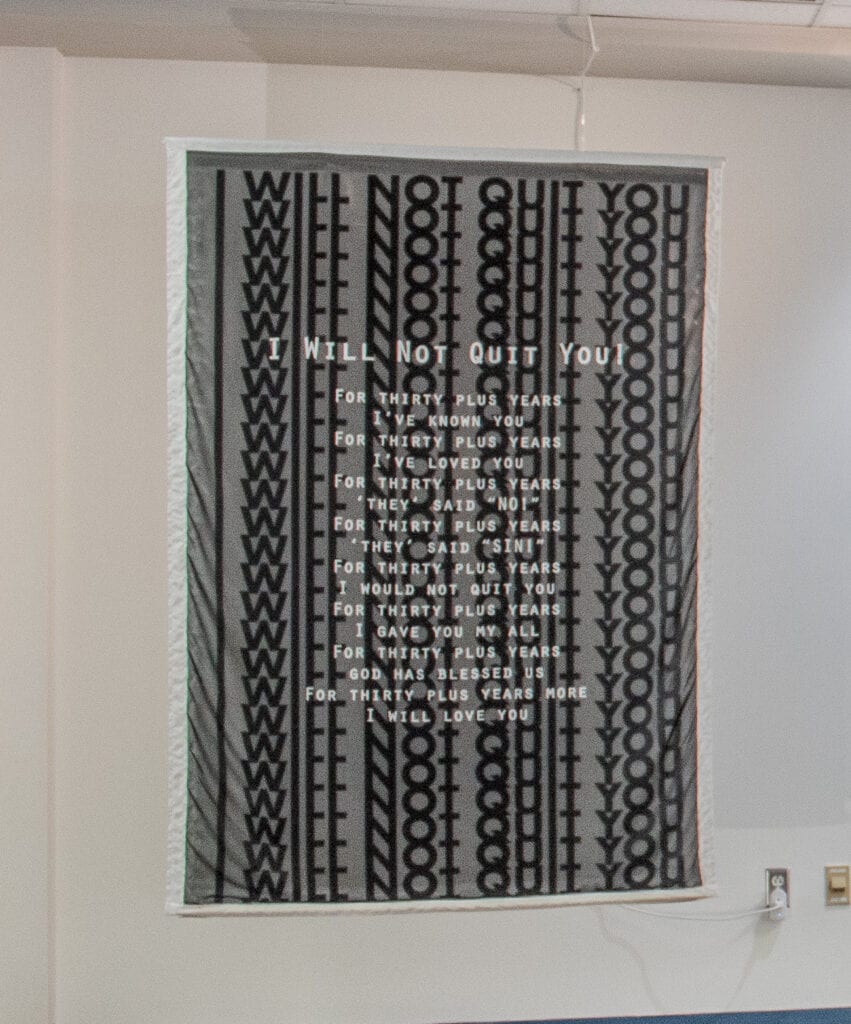March 24, 2021 | By Cindy Stovall
One on One with Saumitra Chandratreya
Through April 17
The Studio@620
Details here

. . .
An ekphrastic is a vivid, often dramatic, verbal description of a visual work of art.
In our neck of the woods, we see ekphrastic collaborations all the time. With a plethora of talent in poetry, literature, visual arts, theater, music and dance, it was inevitable that artists of different genres combine the power of their diverse voices to express one artistic vision. It’s kind of our thing.
By its purest early definition, ‘ekphrasis’ means the physical art comes first, followed by a written interpretation, usually in the form of a poem. Well, visual artist Saumitra Chandratreya and poet Kevin Mooney didn’t get the memo – and we are the better for it.
When you see The Secret Language of Intimacy, the soul-stirring exhibit at The Studio@620, you’ll see dramatic large-scale hanging fabric panels where the poetry comes first – and the words inspire the abstract design of the fabric.
“I enjoy making images that are not based on things that are tangible,” says Saumi, “things like feelings and emotions.”
Mooney’s poetry certainly provides that. “I write about the emotional energy that is created between two people,” he says. “Some poems are evoked by personal experience while others represent an empathic observance of another person’s inner emotional turmoil.”
The verses are beautiful, powerful, gut-wrenching at times – just like love.

I recently had a chance to chat one-on-one with Saumi, the young artist with the chic gender re-defining personal style, who has barely been in the United States for five years – yet has established himself as a highly sought-after fixture in the Pinellas County arts scene and beyond.
C: How did this collaboration come about?
S: “I was already a fan of Kevin Mooney’s poetry and owned two books of his poetry. The opportunity to collaborate presented itself, and what started as a grant search, has evolved into a multi-show creative partnership.”
C: What does the process look like? How do you decide on which design goes with a poem?
S: “For this project, we would start with one of Kevin’s poems on love and relationships. Then, after sitting with the words for a while, I would create several designs evoked by the words and my interpretation of them. Kevin previews the designs, and we discuss back and forth. He always defers to my final choice, but we very much work together until the final design is decided upon. It then becomes the template for the final fabric piece.”
The fabric panels and poems are displayed together, each in two pieces, and hung from the ceiling to create a dramatic installation. The overall experience is immersive for the viewer – both visually and emotionally. Smaller-scale wall art pieces are also on display for those who might be “spatially challenged.” All are available for sale.
On a Personal Note…
C: I’d love to know more about your journey and who you are. Tell me about your early life.
S: “I was born in 1990 and grew up in a Mumbai suburb (Dahisar) with my parents, grandparents and sister. My father, an electrical engineer, was a bit of a workaholic and my mother worked in finance, so I spent a lot of time with my grandparents. My grandfather worked for the Indian railways, so we would walk to the station and I became fascinated with trains. The designs of different rail cars fascinated me. We would meet my mother coming home from work and walk home. It was a lovely life.”

C: Where did your interest in art come from?
S: “Firstly, my grandfather was a portrait painter and was a great influence on me. He was not permitted to pursue art as a career, so he would encourage us with crayons and pencils. I often drew on the walls when other media was not available. Secondly, I went to public school and had an art teacher who saw something in my work. She encouraged my parents to seek additional art training for me outside of school. This teacher entered my work in a state competition where it placed 7th. In second grade, she also submitted my work for display in an exhibition in Japan. I was completely uninterested in sports, so art became my outlet.”
C: Did your parents support your desire to pursue art?
S: “I didn’t always have a direct track – I was interested in things like architectural and industrial design, but I knew I wanted a creative career, and they supported that. What was clear is that they did want me to pursue higher education and they wanted me to be happy in my career choice. I never felt pressured to follow a career path other than what I wanted.”
C: So how did you land on textile design?
S: “During my undergraduate education in India, I was in a wonderful program that exposed us to all foundational forms of art and design. I became fascinated with the work of the students creating textiles, and I learned how to weave, dye and print materials. When the time came to choose a major, that’s what felt right to me.”
C: So, you came to the US to pursue an advanced degree? What was the adjustment like?
S: “Yes. I got my undergrad degree in 2013. At the time I was an assistant designer at a few places and doing freelance design for theater and film. I had the opportunity to go to school in either London, New York City, Michigan or Chicago. After a lot of consideration, I chose the Art Institute of Chicago in 2015. Amazingly, I felt quite at home. The urban feel was very similar to Mumbai, so it was familiar. What was very different was the political climate. The 2016 election was heating up and there was a lot of tension surrounding that. It was very strange.”
. . .

. . .
C: How did you come to be in St. Petersburg?
S: “I met my now husband, Dudley, during my time in Chicago. He always wanted to live in Florida and so he came down and I followed later. It was clear that St. Petersburg was the perfect arts destination, so we bought a home here in and it’s been an amazing time of growth for my work ever since.”
C: Let’s talk about your personal style for a moment. How does it express who you are?
S: “I love fashion – both masculine and feminine. Part of my fascination with textiles came from the beautiful garments worn by Indian women. It all seemed in concert with my queer identity. So, if I want to wear a sequined top and carry a shoulder bag, it’s how I want to express myself in that moment.
I use ‘he, him his’ pronouns or ‘they, them theirs.’ Though I continue to figure it out, the way I see myself is fluid and I am very comfortable with who I am. While my family, who still live in India, may have trouble understanding and worry about me, they still love and want the best for me. It’s an area of peaceful co-existence. It helps to have a chosen family right here where I am. It’s a very good life.”
. . .
Look for these upcoming shows featuring the work of Saumitra Chandratreya
Fairgrounds St. Pete at The Factory in the Spring
Nude opening April 9 at the Mize Gallery
Rainbow opening June 4 at the Mize Gallery during Pride
Camp at Emerald Bar in June, curated by artist John Gascot


